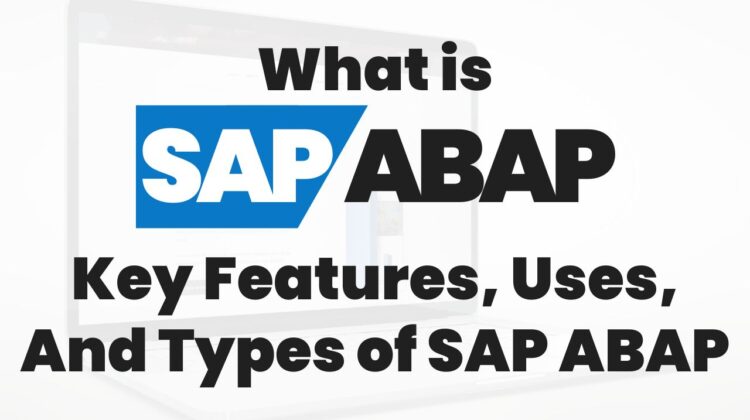
What is SAP ABAP? Types, SAP ABAP Full Form, and Uses
What is SAP ABAP? Types, SAP ABAP Full Form, and Uses
SAP ABAP (Advanced Business Application Programming) is a high-level programming language used for developing business applications in the SAP environment. ABAP is primarily used to develop and customize applications within the SAP ERP (Enterprise Resource Planning) system. It enables developers to create and modify SAP applications to suit the specific business requirements of organizations.
Table of Contents
SAP ABAP Full Form:
SAP stands for “systems, applications, and products“. ABAP stands for “Advanced Business Application Programming.”
Key Features And Uses of SAP ABAP:
ABAP was initially developed by SAP for creating reports and transactions in the SAP R/3 system. Over time, it evolved into a full-fledged programming language, capable of handling complex business logic and data processing tasks. ABAP plays a vital role in customizing SAP applications and integrating them with other systems.
1. Business Logic:
ABAP enables developers to implement complex business logic, data processing, and algorithms within SAP applications. It allows the creation of custom functions, routines, and calculations to support specific business requirements.
2. Data Handling:
ABAP provides powerful tools for handling and manipulating data in SAP systems. It supports database queries, data extraction, transformation, and loading (ETL), as well as data validation and conversion.
3. User Interface:
ABAP is used to create user interfaces in SAP applications. Developers can design custom screens, forms, and reports to enhance the user experience.
4. Integration:
ABAP facilitates seamless integration between different SAP modules and external systems. It allows communication with other SAP systems, non-SAP systems, and web services.
5. Enhancements:
ABAP provides various mechanisms for enhancing standard SAP applications without modifying the original code. These include user exits, Business Add-Ins (BAdIs), and enhancement spots.
6. Custom Development:
Organizations often require unique functionalities that are not available in standard SAP solutions. ABAP enables developers to create custom programs and solutions tailored to specific business needs.
7. Reporting:
ABAP supports the creation of custom reports to present data in a structured and meaningful way, providing actionable insights for decision-making.
8. Workflow Automation:
ABAP can be used to automate business processes through workflows, reducing manual intervention and improving efficiency.
9. Performance Optimization:
Developers can use ABAP to optimize the performance of SAP applications by tuning code, implementing proper indexing, and employing best practices.
SAP ABAP has evolved over the years, and with the introduction of SAP S/4HANA, the focus has shifted to SAP HANA as the underlying database, providing in-memory processing capabilities and enabling real-time data analysis.
As SAP continues to innovate and improve its product offerings, ABAP developers play a crucial role in maintaining, enhancing, and developing new functionalities in the SAP ecosystem, ensuring that businesses can leverage SAP applications to meet their ever-changing needs.
Types of SAP ABAP programs:
1. Report Programs:
These programs are used to generate custom reports, displaying data in a structured format based on specific business requirements.
2. Dialog Programs:
Dialog programs facilitate user interaction with the SAP system. They are used to create custom transaction screens and process user inputs.
3. Function Modules:
Function modules are standalone units of functionality that can be called from other programs to perform specific tasks.
4. SAPScript and Smart Forms:
ABAP is used to create and customize layout sets for printing forms such as invoices, purchase orders, etc., using SAPScript or Smart Forms technology.
5. Data Conversion Programs:
These programs are responsible for data migration and transformation during system upgrades or data transfers.
6. Enhancements:
ABAP is used to implement custom enhancements in standard SAP programs without modifying the original code.
7. Business Add-Ins (BAdIs):
BAdIs are used to enhance the functionality of SAP applications through custom implementations without altering the standard code.
8. User Exits:
User exits are specific points in standard SAP programs where custom ABAP code can be added to enhance functionality.
9. Object-Oriented ABAP (OOABAP):
ABAP also supports object-oriented programming concepts, allowing developers to create classes, objects, and inheritance-based structures.
Conclusion:
SAP ABAP is a powerful programming language used to develop, customize, and extend business applications within SAP. It enables complex business logic, data handling, UI creation, integration, and optimization. ABAP developers play a crucial role in tailoring SAP applications to meet specific business needs, ensuring efficiency and competitiveness.
Interested in learning SAP ABAP Course? Click on the link below and connect with our expert career advisory team now.












